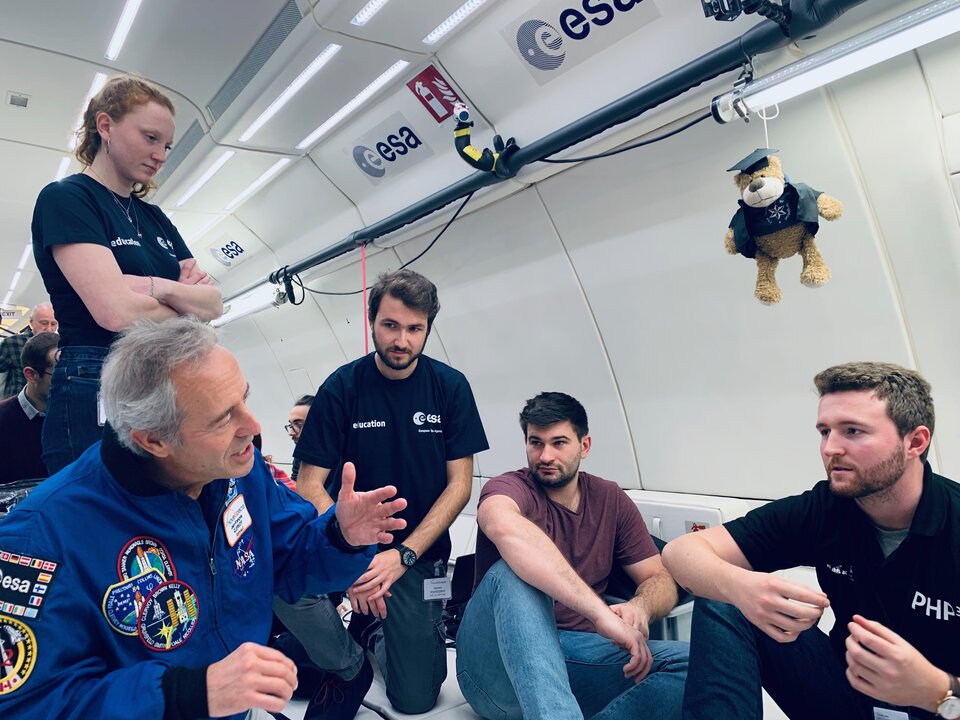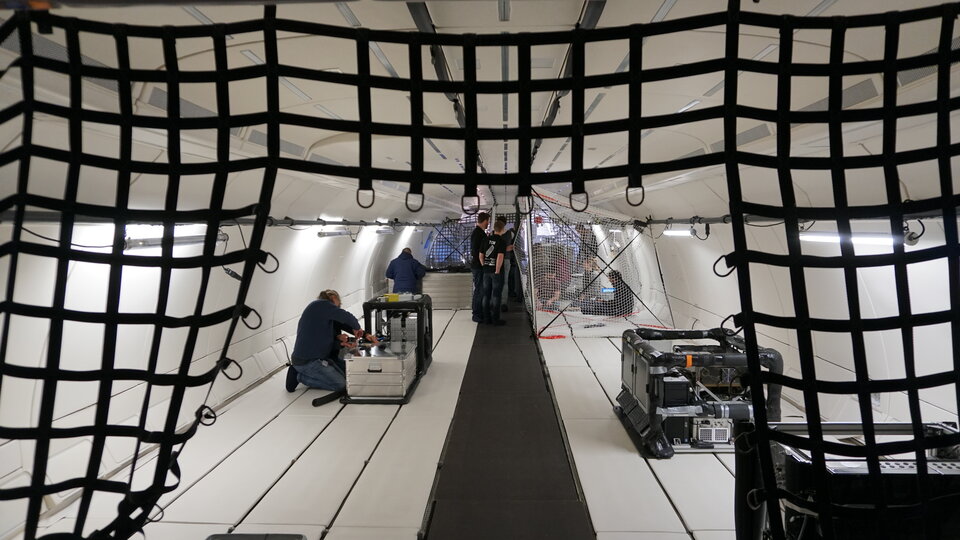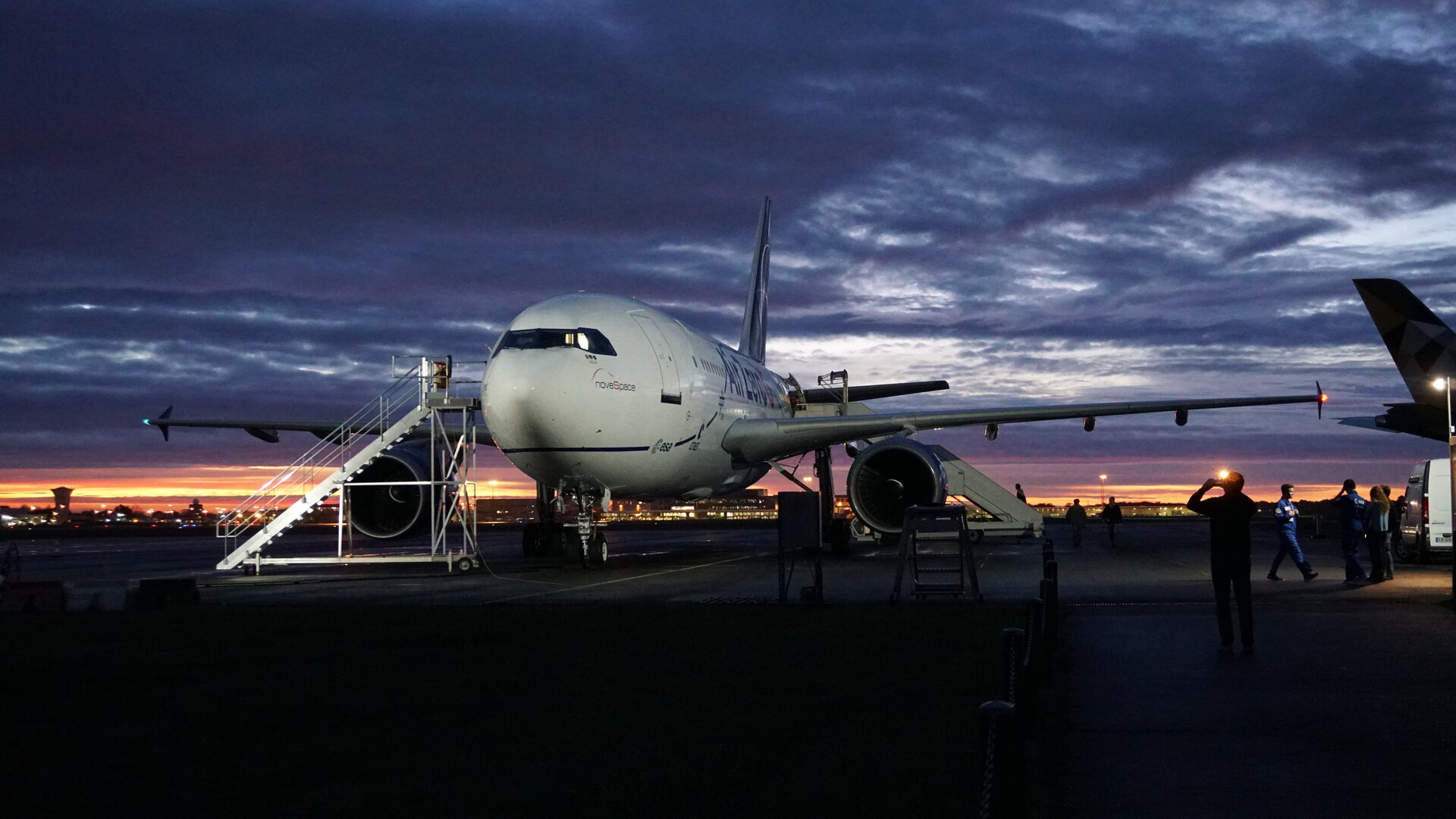Parabolic flights
What is a parabolic flight?
A parabolic flight is the term used to describe a specific manoeuvre affecting the attitude and the trajectory of an aircraft in flight that negates, as much as possible, the effect of Earth’s gravity (g). The manoeuvre resembles a ballistic trajectory, which is in fact the apex of a highly eccentric ellipse with one focus at the centre of the Earth. This orbit however traverses for the most part through the Earth’s mantle and core thus limiting the usable portion to a few kilometres of trajectory in the Earth’s atmosphere. The aircraft therefore follows this small portion of the orbit for a short duration only, approximately 22 seconds. During these 22 seconds, in theory, the aircraft is in orbit and as such also in freefall, negating all of Earth’s gravitational forces thus rendering the aircraft, and its contents “weightless”. In practical terms however, because of small perturbations in the flight conditions and the atmospheric resistance, only centi-milli- gravity levels (10-2g - 10-3g) can be achieved.
Enjoy the video below to discover all the platforms! For the Parabolic Flights chapter go to minute 38:23.
Find out more Parabolic Fights with Novespace.
In order for the aircraft to follow the apex of the orbit, it must accelerate and pitch upwards gradually to approximately 50 degrees, the pull-up. This creates an environment of hyper gravity (almost 1.8g) in the z-axis of the aircraft (towards the floor of the cabin). Upon reaching 50 degrees pitch, the pilots cut back on thrust just enough to counter atmospheric drag. From this moment of ‘injection’ into orbit the aircraft experiences centi- to milli- gravity levels. Pilots deftly control the aircraft along the orbit/parabola for 22 seconds reaching over the apex and falling back towards Earth, at which point they redress the aircraft to level flight. The redressing manoeuvre, the pull-out, causes another environment of hypergravity (1.8g) in the z-axis of the aircraft. Thus, every centi- milli-gravity phase begins and ends with a hyper gravity (1.8g) phase. This parabolic manoeuvre is repeated 30 times a day over 3 days for each campaign.
Fluctuation of g levels and mechanical vibrations

It is clear that the use of parabolic flights has many advantages over actual space flight, namely:
- Relatively low cost of design and production of an experiment
- Possibility to carry out several series of experiments during three flights on consecutive days, each flight yielding about 30 parabolas, for a total of about 10 minutes of microgravity per flight
- Possibility of interaction of the scientists and operators with their experiment.
As described above, during a parabolic flight not only centi/milli-gravity and normal gravity conditions are experienced: each parabola consists of three phases, the low gravity phase being in the middle. During the two other phases (i.e., the pull-up and the pull-out) the occupants are subjected to 1.8 times the force of gravity. Experiments can therefore be designed to take advantage of these 1.8 g phases, or at least they should not be negatively influenced by them.
It is important to note that the transitions between the 1.8 g and the low gravity phases are not instantaneous. At the end of the pull-up phase, when the plane is flying at a pitch-angle of 50º, the pilots manoeuvre to cancel the lift generated by the wing by inclining the plane along its pitch axis to have the angle of attack equal to zero. At the same time, the flight engineer reduces the thrust from the engines to compensate the small drag generated in this configuration. This procedure is carried out as quickly as possible and, as a result, short phases of negative g (gravity pulling upwards) may be experienced. This transition phase lasts approximately 3 seconds.
In addition, weightlessness cannot be perfectly attained because of the presence of other forces besides gravity. The plane is still surrounded by air and thus aero-dynamic lift, drag and thrust are still present to some extent. The pilots are always trying to compensate these disturbing forces. As a result, the microgravity level attained in a parabolic flight has some variations on the order of +/- 0,05 g at a frequency of around 1 Hz.
As in any type of flight, mechanical vibrations caused by engines and shocks in the plane are also present but, in this case, they are noticeably higher due to the performance of the plane and the nature of the flight. Consequently, experimenters must pay special attention to the design of the experiment set-up in order to prevent vibrations from, for example, distorting the results or spoiling the samples (e.g. sensitive optical devices).
As a final remark, experiments involving free-floating objects (i.e not connected by any means to the plane) do not enjoy the whole 22 seconds period of microgravity. Free floating objects released in the cabin will impinge on the fuselage within a few seconds due to the attitude of the aircraft constantly changing. There are also safety issues associated with this type of experiment and enough time must be left to release the sample and to secure it before the low gravity phase ends. As a result of this, the actual test time frame available for this kind of experiment should be considered to be maximum 5 seconds.
Technical constraints

While defining their projects, applicants should keep in mind the following constraints that apply to the experiments. Please find below a list of criteria that would result in the project being rejected:
- The systems, equipment and procedures involved in the experiment present risks that Novespace is unable to manage;
- The experiment involves one or more of the following:
- Combustion experiment;
- Radioactive substance or apparatus emitting ionising radiations, requiring an authorisation from the ASN (French radioprotection authority);
- Radioactive source;
- X-Ray generator;
- GMO, class 2 or primate cell line;
- Lithium batteries in non-COTS free-floating equipment;
- Laser, class 4;
- Animal research (vertebrates or cephalopods).
Further discussion is required on the following criteria:
- The experiment does not appear to be compatible with the background or level of expertise of the students;
- The experiment will require more than 2000 x 2000 mm of ground surface;
- The experiment will require more than two flyers;
- The experiment involves one or more of the following:
- Flammable liquids or vapours, toxic, explosive products;
- GMO, class 1, from a non-primate cell line;
- System with a pressure x volume (P.V) product above 4L.bar;
- Equipment capable of reaching extreme temperatures (liquid: max 49°C, material: max 60°C);
- Heavy equipment or assembly (> 20 kg);
- Lithium batteries in non-COTS equipment;
- Electromagnet;
- Laser, class 1M or above;
- Laser, class 3R/3B;
- High-energy system (centrifuge, flywheel, springs, ...);
- Extreme magnetic fields, high voltage or high electrical power.
- For experiments with human test subjects please refer to ESA - How to apply under the section Parabolic Flight.
In addition, the following recommendations are made with regard to the technical constraints:
- The set-up of all electrical equipment (including all connectors and wiring) should be carried out by a professional electrician;
- The mass of free-floating modules should be limited to 10kg. Also, they should be restrained (e.g. cage, tether, netted area) to limit uncontrolled movement;
- The total liquid quantity within an experiment should remain within half a litre, and double sealed containers should be used;
- The mechanical set up should be prepared by a professional workshop technician.
Platform specific documents
Introductory Note, Novespace
For more information regarding these aspects, please refer to the Novespace 'Introductory Note'.
The purpose of this document is to provide students with:
- information regarding technical & safety selection criteria
- level of information requested for filling the first revision of the ESDP at selection step
- general advice and tips for managing the project.
ESDP
A template of the mentioned Experiment Safety Data Package (ESDP) can be found here. The ESDP is to be completed at the time of the design of the experiment. It includes all the technical information regarding safety. Based on this document, the prime contractor will decide whether the experiment is authorised to fly. A first draft version is expected to be delivered with the experiment proposal for the selection process and the final version will be prepared before the campaign.
Please note that this document is updated on regular basis. The participants are responsible for downloading the last applicable version before filling it in.
Terms and Conditions for Participation in ESA Parabolic Flight Campaigns
This document describes in detail the roles and responsibilities of all the participants in the Parabolic Flight Campaigns. This agreement or updated version thereof, must also be signed in order to participate in the campaign. They must be read and understood by all the participants prior to the campaign and includes a statement that must be signed by the students, as well as by the endorsing professor / academic of the selected teams. Teams are encouraged to provide these documents to the university legal administration as early as possible to ensure the university can sign the agreement and allow student participation.
Medical Requirements for Parabolic Flights
All parabolic flight participants are asked to comply with medical criteria, in preparation for the campaign.
The Campaign
Following the design development and testing of the experiment, teams must ship or bring their assembled racks to Novespace premises in time for the campaign. The campaign lasts two weeks with the first week being dedicated to finalising the experiment assembly after shipping, completion of safety checks and documentation with Novespace staff and integration into the aircraft cabin. The second week of the campaign is flight week offering 3 flights of 31 parabolas. Unless clearly stated in the announcement of opportunity, all student campaigns are centi- milli-gravity (10-2g - 10-3 g campaigns (not partial/Moon or Mars gravity). At the end of the campaign, experiments are removed from the aircraft and shipped or driven back to the team’s institute.
Please note that the conditions detailed above are subject to change without prior notice.



